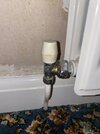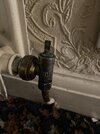Hi, I’ve tried removing a couple of old radiators so I can remove the wallpaper behind, get it plastered and with a view to have new rads fitted.
The nuts are totally seized and I’m reluctant to try too much brute force in case I fa age the pipes. Then I’m really up the creek…
One thing I read was to drain the system and remove the smaller vertical nut and take the rad off with the valve still attached.
I think I am ok with this up to this point but what don’t do once the rad is off? Is there a way to cap off that vertical pipe as I will need to turn the boiler back on for hot water in the shower etc even though we don’t need the heating on yet.
Thank you in advance
The nuts are totally seized and I’m reluctant to try too much brute force in case I fa age the pipes. Then I’m really up the creek…
One thing I read was to drain the system and remove the smaller vertical nut and take the rad off with the valve still attached.
I think I am ok with this up to this point but what don’t do once the rad is off? Is there a way to cap off that vertical pipe as I will need to turn the boiler back on for hot water in the shower etc even though we don’t need the heating on yet.
Thank you in advance



